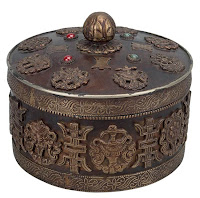 The Buddhist ritual box is nicely
designed with astamangala symbols being inscribed on it. These astamangal
symbols are the sacred symbols for Buddhism and reflect the teachings and
various events of Buddha. Here eight auspicious signs of Buddhism are nicely
depicted. Astamangalas are the eight jewels of Buddhism, eight pillars of Buddhism.
The Buddhist ritual box is nicely
designed with astamangala symbols being inscribed on it. These astamangal
symbols are the sacred symbols for Buddhism and reflect the teachings and
various events of Buddha. Here eight auspicious signs of Buddhism are nicely
depicted. Astamangalas are the eight jewels of Buddhism, eight pillars of Buddhism.
Astamangala (The Eight Auspicious
Signs) are eight different aspects of Buddhism. They include White Parasal,
Golden Fishes, Sankha, Dhvaja, Srivatsa, Kalasa, Padma, Chamaru. They appear
all together or in part as a decorative motif in stone, wood, metal and
painting.
Astamangalas are believed to represent
the gifts given by celestial beings to Sakyamuni following his attainment of
Enlightenment.
Umbrella or White Parasal gives us
protection from evil desires and embodies notions of wealth or royalty. It
points to the "royal ease" and power experienced in the Buddhist life
of detachment.
Two Fishes or Golden Fish symbolizes
beings rescued from the ocean of misery of earth. Whosoever practices dharma
needn’t fear about suffering, and can swim at ease like a fish in the water.
The Conch or Sankha: The white Conch
shell symbolizes the deep, far reaching and melodious sound of the teachings.
 Dhvaja or The Victory Banner symbolizes
the victory of the Buddha's teachings over death, ignorance, disharmony and all
the negativities of this world.
Dhvaja or The Victory Banner symbolizes
the victory of the Buddha's teachings over death, ignorance, disharmony and all
the negativities of this world.
Srivatsa or Endless knot or Mystic
diagram symbolizes of the endless cycle of rebirth. It also represents the
infinite wisdom of the Buddha and the union of compassion and wisdom.
Kalasa or The Treasure Vase represents
all spiritual wealth and is a sign of the inexhaustible riches available in the
Buddhist teachings.
The Lotus is a symbol of purity both
for the Hindus and the Buddhists. It is a symbol of complete purification of
body, speech and mind.
Chamaru symbolizes Tantric
manifestations. Made of yak tail attached with silver staff, it is used during
ritual recitation and fanning the deities on an auspicious religious ceremony.